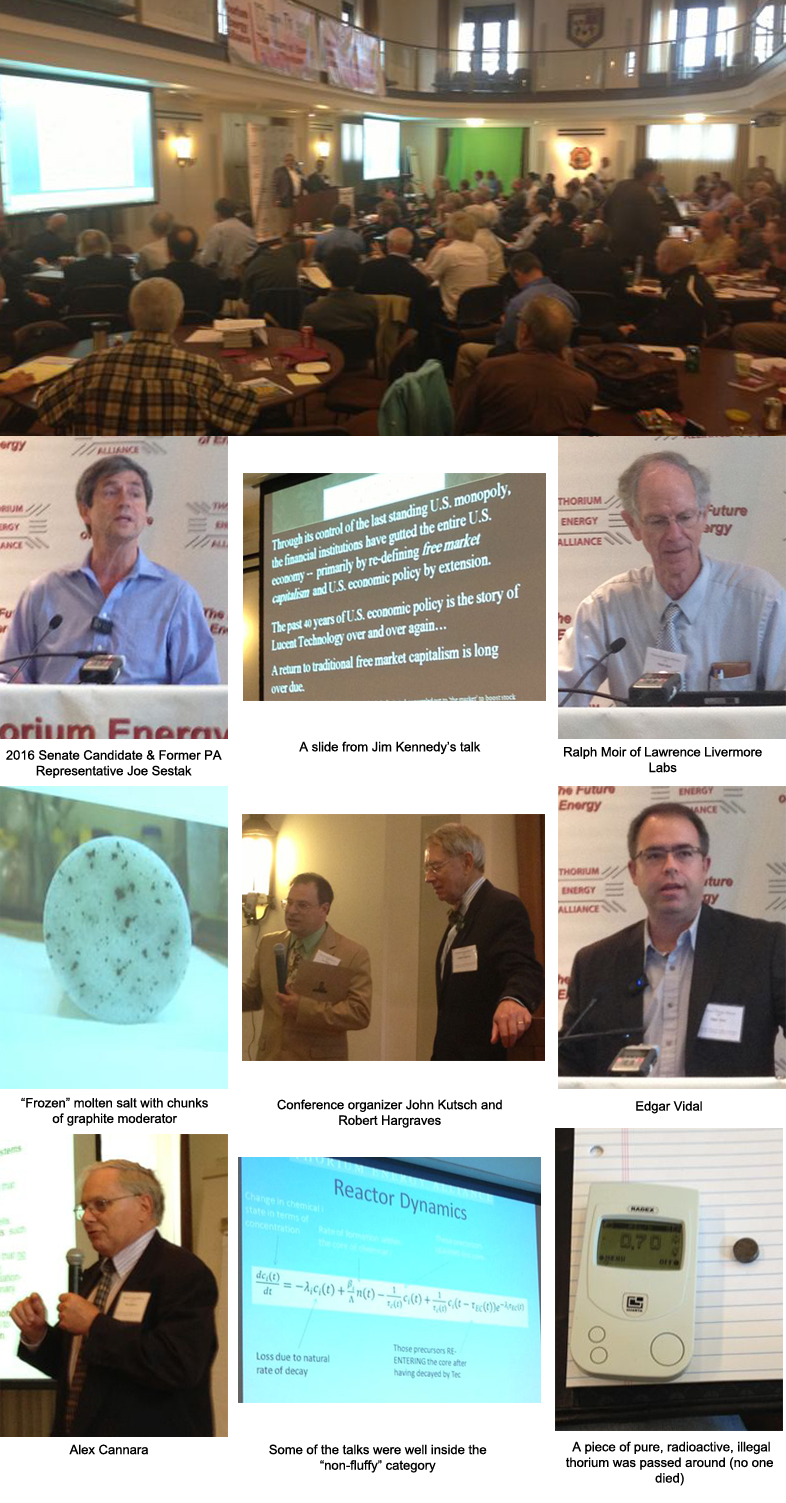Environment & Energy
Related: About this forumReport from TEAC5 (Thorium Energy Alliance Conference) in Chicago
I had the pleasure of attending this year's Thorium Energy Alliance Conference, the fifth annual gathering which briefly becomes North American headquarters for Gen IV nuclear each year. The conference was two days of lectures covering all facets relating to the adoption of safe nuclear, including environmental, investment, and political. Highlights:
Joe Sestak, former PA representative and 2016 Senate candidate spoke frankly about how adoption of MSRs in America's energy picture will require a "strange bedfellows" alliance with natural gas.
Jim Kennedy, one of the founders of TEA and a tireless political campaigner, spoke of his experiences discussing MSRs with Harry Reid and Orrin Hatch, the impetus for the (failed) Thorium Energy Independence Act of 2008, and how China, by monopolizing a $3 billion REE (rare earth elements) market, has managed to leverage that into control of the $4.6 trillion market of the products which depend on them. Jim's expansive discussion broadened into how Milton Friedman and the Chicago School of Economics has destroyed the idea of market capitalism that built America by initiating a "garage sale" of America's collective investment in technology to private interests.
David LeBlanc, nuclear physicist and force behind Terrestrial Energy Inc., spoke of his project for making small MSRs to power isolated settlements in the Canadian north which are being abandoned because of the cost of energy.
Alex DeVolpi and Ralph Moir, of Argonne National Labs and Lawrence Livermore Labs, spoke about radioisotopoes and the thorium decay chain.
Stephen Boyd, Cavan Stone, and Kim Lawrence Johnson are three brilliant young chemists/physicists who are creating VC opportunities in conventional energy projects using unexplored techniques as a stepping stone to building support for MSRs.
IP attorney Michael Fernal spoke of his IP work with Fortune 500 companies and the importance of America addressing IP enforcement in China.
Ralph Hart is the CEO of Northern Nuclear Industries, Inc. which is seeking VC funding for a TRISO (pebble bed), molten-lead cooled reactor design.
Bert Stitt spoke about the psychology of consensus building.
Robert Hargraves, author of Thorium: Energy Cheaper than Coal gave an overview of reactions of his book and avenues for addressing misconceptions about nuclear power in general.
Andrew Dodson spoke about reactor system control and integrating MSRs with renewable resources.
Physician Alex Cannara spoke about addressing radiation health concerns, and gave a sobering assessment of his take on the climate change's biggest impact of all: in 20-30 years ocean acidification will make life for plankton impossible, quickly destroying the world's ocean food chain.
Edgar Vidal is is a sales rep for Materion, a leading world supplier of the element beryllium. He described his efforts to create a sales stream for FLIBE (flouride/lithium/beryllium) salt for his company to aid the feasibility of MSR development.
Ganapati Myneni of the University of Illinois Nuclear Physics Dept. spoke of value of Monte Carlo mathematical simulations of nuclear reactions for R&D of molten salt reactors.
The spontaneous, informal discussions which arose during breaks was the best part of all. I'd recommend this highly to any E/E DUers who can make it to Chicago for a couple of days next year - you won't be disappointed.

kristopher
(29,798 posts)The Ford Nucleon

And then there is this comment by dio82 in response to Does a new approach to nuclear make economic sense?
http://arstechnica.com/science/2013/05/does-a-new-approach-to-nuclear-make-economic-sense/
The main reason for this is licensing burden. And by licesning burden I am not meaning the design, actions and components necessary for ensuring safety. By licensing burden I am meaning the burden on prooving sufficent quality.
This is the main cost driver. A safety class one pump will cost somewhere of the order of $5 million. Perhaps $10 million. $4.8 million of that is purely due to the necessary paper work to get a fully traceable ASME N-stamp on everything. Once the pump is installed, there will be three to four binders full of ASME quality control sheets, just for this single pump. Making this pump smaller or larger will not appreciably affect the volume of qualification tests, witness documentation points and personal certificates.
The main benefit from assembling everything in a single factory is that some of the ASME quality control documentation can be reused for multiple parts. Also, a proof of quality is much easier to do in a clean factory environment under controlled conditions than out in the middle of no-where of a nuclear coonstruction site.
What matters for cost is the pure component count, weld count, civil structures count. And most of this is relatively fixed due to physics and the need to handle single faults, common mode faults and risk reduction goals.
Now, small reactors have the benefit of slower accident progression due to decay heat (the ratio of decay heat input versus internal water volumes is much better), so the designs can be even more passive than the AP1000. That is good, since that will reduce components again. But, the main problem remains: Proof of quality costs, and these costs do not scale with size.